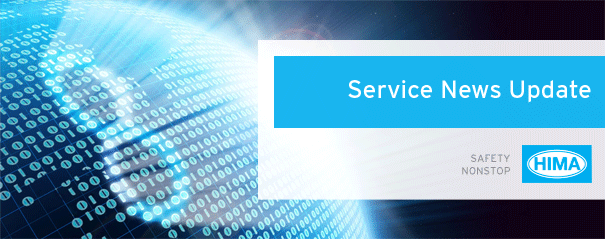 |
|
August 2009
◄
|
|
►
Content |
|
|
►
Software
Tip |
|
|
►
Downloading to HIMA PES Devices |
|
|
►
HIQuad |
|
|
►
HIMatrix |
|
|
►
HIMax |
|
|
►
Ethernet/Serial Communications |
|
|
►
Functional Safety - What is a Safety Integrity Level (SIL)? |
|
|
►
Upcoming Courses
|
|
|
► TÜV
Functional Safety Program |
|
|
►
Analysis and Design of Safety Instrumented Systems
Course |
|
|
►
Operation and Maintenance of Safety Instrumented Systems Course |
|
|
►
HIQuad
Maintenance Course
|
|
|
► HIMatrix
Maintenance Course |
|
|
►
Contact |
|
|
|
►
Software Tip |
|
Downloading to HIMA PES
Devices
Depending on the controller used and the operating
system revision, different options are available to the user when
transferring new or modified code into a HIMA PES.
|
|
|
HIQuad
HIQuad devices allow code to be downloaded if both processors are
in STOP mode. If a download is performed in RUN mode, the HIQuad system
will enter STOP mode first. When the HIQuad controller is in STOP mode,
outputs are driven to their safe state and inputs are not being scanned.
The plant being protected will also be in a safe (shut down) state.
It is also possible for a
project to be downloaded or more specifically
reloaded
to a HIQuad processor while it
is in RUN mode. In RUN mode all outputs are being controlled by the PES
and inputs are being scanned. Performing a reload will not upset the
plant.
When reloading to a HIQuad in
RUN mode it is important that the logic has been code generated for "reloadable
code". If the logic has been heavily modified it is possible that some
of the changes may not be compatible with the reloadable code option. If
this is the case, the PES must be placed in STOP mode before
downloading.
|
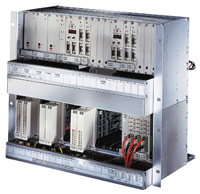 |
|
 |
|
|
HIMatrix
HIMatrix controllers are usually installed in non-redundant
configurations. Currently, a HIMatrix controller must be in STOP mode
before a download can take place. When placed in STOP mode, all outputs
are set to their safe state and inputs are no longer scanned. Later
revisions, due Q1 2011 will permit reloading (device remains in RUN) for
HIMatrix processors.
|
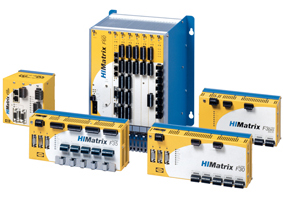 |
|
|
HIMax
Downloading to a HIMax controller can be performed once the processor is
in STOP mode. The HIMax PES is also very flexible when reloading
modified code. An application (logic and/or hardware) can be heavily
modified and a reload is still possible while using a HIMax PES. When
performing a reload, the processor does not enter STOP mode. The
required changes are seamlessly merged into the running logic through
the use of shadow RAM.
|
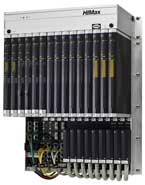 |
|
|
|
Back to contents ▲ |
|
|
|
|
► Ethernet/Serial Communications |
|
Ethernet Communications
|
|
Serial Communications |
|
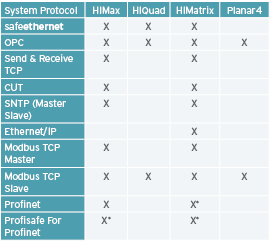 |
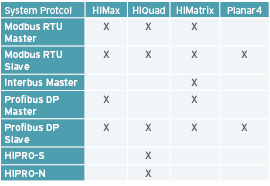
* 01/2011 |
GLOSSARY
COM USER TASK (CUT)
permits the execution of a user developed binary file in a protected area of
the controller. Data can be exchanged between the PES and external systems
via serial (RS232/RS485) or Ethernet TCP/UDP.
ETHERNET/IP
is an open
communications protocol developed by Rockwell Automation. It is designed for
use in machine control and other industrial automation applications.
HIPRO-N
is a
non-safety related protocol that can be used together with HIPRO-S.
HIPRO-S
Is an inter-system SIL3 safety
protocol developed by HIMA for use over serial based media.
INTERBUS
is a serial bus
system, which transmits data between control systems.
Modbus Protocol
is a messaging structure developed by Modicon in 1979. It is used to
establish master-slave/client-server communication between intelligent
devices.
|
OPC
is a series of standard specifications that fill a need in automation like
printer drivers did for Windows allowing for seamless communications over
Ethernet for automation and control systems.
PROFIBUS Decentralised Peripherals (DP)
is used to operate sensors and actuators via a
centralised controller in production technology.
SAFEETHERNET is a
safety related protocol that transmits data over a standard Ethernet
connection to SIL3.
Send & Receive TCP
is a manufacturer-independent, standard protocol for cyclic and acyclic data
exchange and does not use any specific protocols other than TCP/IP.
Simple Network
Time Protocol (SNTP)
is used for time synchronisation.
|
|
|
Back to contents ▲ |
|
|
|
|
► Functional Safety |
|
What is a Safety Integrity
Level (SIL)?
A safety
integrity level (SIL) is a way for an end user to specify how much
protection is required for a safety instrumented function (SIF). A SIF
is the function that detects a hazard and brings the running system to a
safe state. This function must perform within the company’s tolerable
risk criteria. Although a SIL is often seen as simply a number between 1
and 4, which indicates the safety performance of your safety
instrumented function, a SIL provides more information and has more
requirements than an unobtrusive number would indicate. The SIL is a
benchmark the end user needs to achieve to be within its tolerable risk
criteria.
One of the
key factors for a determined SIF to achieve a specific SIL, is to have
devices with proven reliability that have been determined in accordance
with AS 61508. It is usual for suppliers to prove their reliability and
compliance through certification bodies such as TÜV Rheinland. Beyond
this technical requirement are the safety management systems, which
ensure the SIF remains at its desired SIL, throughout its working life.
For the process industry, AS 61511 outlines the technical and
non-technical requirements of the SIL.
It is important to note
that only the end user can specify the required SIL (perhaps determined
from a corporate risk matrix) as they are accepting the risk of the
associated hazard.
|
|

|
|
|
|
Back to contents ▲ |
|
|
|
|
► Upcoming
Courses -
TÜV Functional Safety Program |
|
|
|
TÜV Functional Safety Program
Brisbane | 8-11 December |
 |
World-class
training from a world-class trainer |
|
This course has been developed to provide an overview
of current industry standards, functional safety concepts and current tools
used to determine safety levels while applying industry recognised
techniques and methodologies.
Below are testimonials from
clients who have successfully completed the
TÜV Functional Safety Program with Tino Vande Capelle, HIMA's
TÜV Functional Safety trainer.
"HIMA's Functional Safety Management (FSM) course is in the forefront of
delivering the best knowledge outcomes for achieving world class process
safety standards." Mahesh Murthy
"His knowledge of the subject was excellent and he could give examples from
his own work experience. He could gauge a persons understanding and give
extra help and support if required. From a personal point of view I would
have no hesitation in recommending Tino." Peter Smith
"The course was very helpful and practical, with good quality training
materials. Tino is an excellent presenter who was able to clearly
communicate the concepts and provide examples from his experience to
illustrate the points." Rebekah Mutton
"He proved to be
a highly knowledgeable expert in functional safety with lots of practical
experience. His teaching style is easy-going, entertaining even but highly
effective. I thoroughly recommend Tino as a functional safety expert and
trainer." Tung Nguyen
Click here
to download the
TÜV Functional Safety Program flyer.
For further information please see our
Events page.
|
|
|
|
|
|
Back to contents ▲ |
|
|
|
|
►
Operation and Maintenance of
Safety Instrumented Systems Course |
|
Operation and Maintenance of Safety Instrumented Systems Course
|
Sydney | 8 September
Gladstone | 6 October
Brisbane | 10 November |
Darwin | 22 September
Melbourne | 4 November |
The objective of this course is
to provide operations and maintenance personnel with the knowledge required
to operate and maintain safety instrumented systems (SIS) such that the
designed functional safety is maintained throughout the operation and
maintenance phases of the AS 61511 safety lifecycle.
Click here
to download the
Operation and Maintenance of Safety Instrumented Systems Course flyer.
For further information please see our
Events page.
|
 |
|
|
|
Back to contents ▲ |
|
|
|
|
►
HIQuad Maintenance Course |
|
|
 |
HIQuad Maintenance Course Perth |
1-2 September
Brisbane | 12-13
November
The objective of this
course is to provide detailed hands-on system troubleshooting exposure for
engineers and technicians maintaining HIQuad SIL rated safety systems.
Click here to download
the
HIQuad Maintenance Course flyer.
For further
information please see our
Events page.
|
|
|
|
Back to contents ▲ |
|
|
|
|
►
HIMatrix Maintenance Course |
|
HIMatrix Maintenance Course Perth | 20-21
October
The objective of this
course is to provide hands-on troubleshooting for HIMatrix systems and
insight into ELOP II Factory Software and the HIMatrix controller.
Click here to download
the
HIMatrix Maintenance Course.
For further information please see our
Events page.
|
 |
|
|
|
Back to contents ▲ |
|
|
|
|
►
Contact |
|
For more information visit our website
www.hima.com.au or call
to speak to a safety specialist.
|
|
For service information contact HIMA Service:
Tel: (03) 8645 3602
Email:
service@hima.com.au
|
To register for training
contact HIMA Training:
Tel: (08) 9323 2100
Email:
training@hima.com.au |
|
|
Back to contents ▲ |
|
|